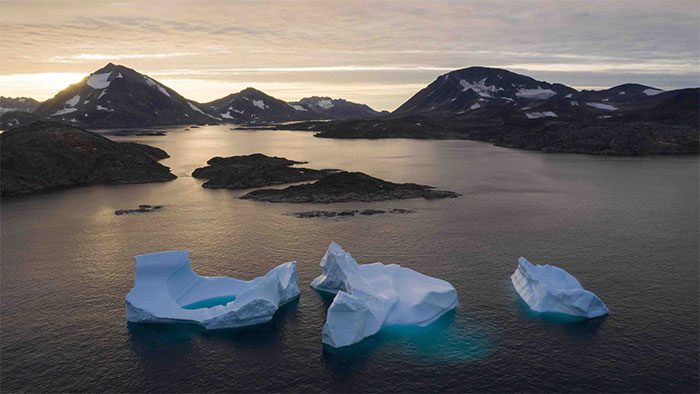A recent study published in the journal Science indicates that if the average temperature rises by an additional 1.5 degrees Celsius, it will lead to irreversible situations and have devastating effects on our planet.
According to research conducted by a team of scientists at the University of Exeter (UK) led by Professor Tim Lenton, once global temperatures increase by 1.5 degrees Celsius, we will face irreversible situations that will “change the face of the world,” with many regions being distorted in terms of landscape and topography.

Ice in Greenland is gradually melting – (Photo: Felipe Dana).
The consequences will be catastrophic for the planet and, of course, for human life. The study published in Science on September 8 indicates that sea levels could rise by up to 10 meters.
Meanwhile, a study by the World Meteorological Organization (WMO) and the UK Met Office released on May 9, 2022, reported that in the next five years, global temperatures could increase by 1.5 degrees Celsius due to record-high greenhouse gas emissions.
The WMO and Met Office warned that from now until 2026, there is a 48% chance that the annual temperature of the Earth will exceed 1.5 degrees Celsius compared to pre-industrial levels.
In Science, Professor Tim Lenton asserted that the only way forward is for humanity to reduce greenhouse gas emissions as much and as quickly as possible.

A family affected by recent floods in Pakistan – (Photo: REUTERS)
Recently, a new study revealed a very likely scenario where rising sea levels could flood coastal cities.
The first study published in the journal Nature Geoscience focused on the Thwaites Glacier, a natural wonder in West Antarctica nearly the size of the state of Florida.
This largest glacier in the world is also known as the “Doomsday Glacier” because if it melts, global sea levels will rise, forcing millions to leave their homes.
Researchers have determined that the Thwaites Glacier is melting at a dangerous rate, and the new study highlights the severity of the issue.
Scientists conducted seabed research to identify the movements of the Thwaites Glacier over the past century. They found that the glacier has been shrinking by about 2 kilometers per year during that time.
This rate is double the current melting rate, meaning that although the current melting is not too rapid, the ice sheet is likely to melt to the point of collapse.
If all the ice in the upstream drainage basin of the Thwaites Glacier were to melt, global sea levels would rise by more than 3 meters.
The second study published in the journal Nature Climate Change, conducted by Dr. Jason Box, a glaciologist at the Geological Survey of Denmark and Greenland, found that the rapid melting of Greenland’s ice sheet will contribute at least 27 centimeters to global sea level rise. This rate is more than double what experts previously estimated.
As co-author of the study, Dr. William Colgan explained to the AP News Agency: “It’s a dead ice sheet. It will definitely melt and disappear from the glacier. Nothing can change that fact, no matter how much we try to protect the environment.”
Dr. William Sweet, a scientist at the National Oceanic and Atmospheric Administration (NOAA) in the United States, has released a technical report on sea level rise. The report published in February of this year seems to reinforce the concerns raised by the two recent studies.
William Sweet’s report predicts that sea levels along the US coastline will rise by 25 to 30 centimeters over the next 30 years. Along the East Coast, the expected increase is between 20 to 35 centimeters; for the West Coast, it is projected to be between 10 to 20 centimeters; and for the Gulf Coast, the figure could reach between 35 to 45 centimeters.
Needless to say, major cities from San Francisco to New York could face severe flooding.





















































